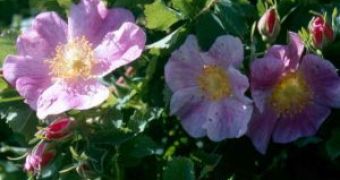The rose has always been appreciated for its beauty and fragrance and has a long history of symbolism and meaning.
Indian researchers found petrified fossils of rose (Rosa sp) 35 million years old, but the rose's genera is for sure much older. Wild roses (photo) grow in the temperate zone of the Northern Hemisphere.
The botanists detected three culture zones from where the rose spread around the world. One is in the Middle East: Babylon, Persia and Syria. From here the rose reached the second most important cultivation center in antiquity: Greece and Rome. A third area is constituted by eastern countries: China, Japan and India.
The oldest known human representation of a flower is that of a rose. It appears on a silver medal found in tomb from the Altay Mountains region (southern Siberia) and it seems to be 7.000 years old.
Written testimonies, dug out at ancient Ur and Akkad (ancient Mesopotamia, current southern Iraq), testify that the Sumerian king Sargon I (roughly 2400 BC) brought from Asia Minor (modern day Turkey), after a military campaign, amongst other loots, vine, fig trees and ?roses.
In ancient Egypt, the rose cultivation entered very late, around 3rd century BC, under the Greek Ptolemaic dynasty. The ancient Greeks and Romans identified the rose with their goddesses of love (Aphrodite, respectively Venus). In Rome, a wild rose would be placed on the door of a room where confidential matters were discussed. Red and white roses mean unity, pink means grace and fragility, yellow means joy.
The phrase "sub rosa" (under the rose) meant to guard a secret.
Early Christians regarded the five petals of the wild rose with the five wounds of Jesus, but they hesitated to adopt it because of its association with Roman excesses and pagan ritual. Eventually, the red rose was adopted as a symbol of the blood of the Christian martyrs. Roses also later came to be associated with the Virgin Mary.
Rose culture came into its own in Europe in the 1800s with the introduction of perpetual blooming roses from China. Currently, thousands of varieties of roses developed for bloom shape, size, and fragrance and even for lack of prickles.

 14 DAY TRIAL //
14 DAY TRIAL //